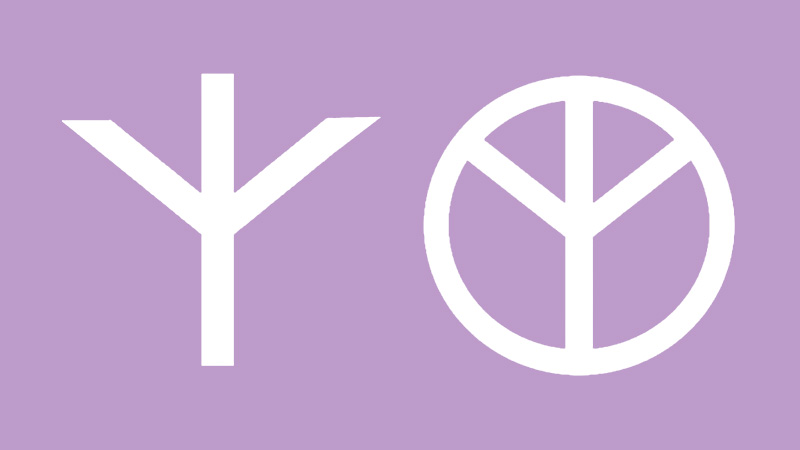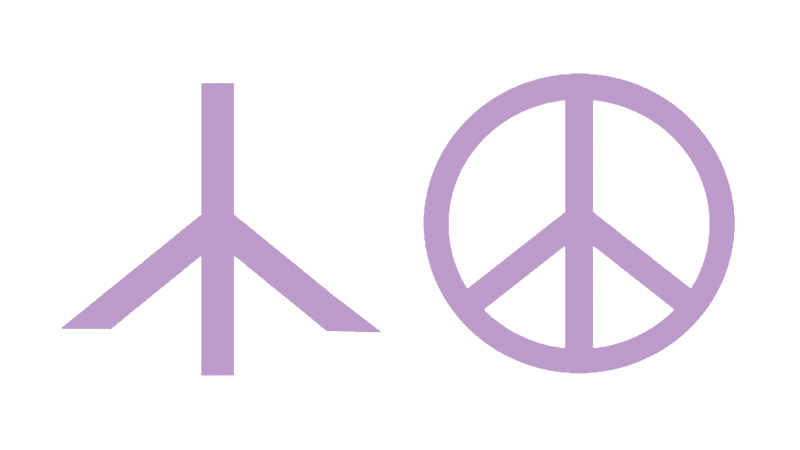We spend our days surrounded by symbols, often unaware of their origins despite being exposed to and affected by them.
One such image, which has become a fundamental part of our culture, is the “Peace” symbol.
The commonly accepted origin story for the “Peace” symbol is that it was created by the designer Gerald Holtom for the Campaign for Nuclear Disarmament (CND) in the United Kingdom. Holtom used the semaphore signals for the letters N and D as the basis for the symbol, which he designed in 1958. To this day, the “Peace” symbol persists as a cultural representation of anti-militarism.
Holtom said of his creation:
“I was in despair. Deep despair. I drew myself: the representative of an individual in despair, with hands palm outstretched outwards and downwards in the manner of Goya’s peasant before the firing squad. I formalised the drawing into a line and put a circle round it.”
The symbol was born when its creator was deeply depressed. The position of the lines captured his emotional state at the time. As we will explore, his design is in fact the symbol for despair.
Symbols act on our subconscious. This is what makes them powerful at communicating ideas and creating emotions. If a symbol is negative, the effect on us as viewers is likewise negative. What we see affects us, often in ways we are not aware of or do not understand. In the same way that looking upon a symbol of positivity can make us feel happy, active, and hopeful, exposure to a negative symbol has the opposite impact on our thoughts, feelings, and actions.
A classic example of this is the swastika, most strongly associated with the Nazis and, thereby, with hatred, destruction, and death. The original use of the swastika was as the Hindu symbol for life, dating back thousands of years. When the Nazis adopted the swastika as their symbol, they intentionally inverted it. The rest, as they say, is history.
With this in mind, let us return to the “Peace” symbol so that, by being aware of its origins and effects, we can use it positively.
According to some, the Peace symbol derives from the two historic Christian symbols of the empty circle (indicating the formless void prior to creation [Genesis 1:2]) and the forked lines (indicating God’s gift of deliverance [John 3:16]).
Other interpretations have included that the two arms without the circle recall an “individual in despair”; the circle represents the uterus and therefore generations not yet born, and more broadly the world; the black colour represents eternity.
Yet another unofficial explanation is that the symbol represents Christ’s cross with its arms lowered as a sign of despair.
As we will see below, the symbol is also the Death Rune from the Futhark runic alphabet.
The starting point is the rune Algiz/Eiwaz also known in the short form of the alphabet as Man.

This Rune is considered positive. It is tied to sacred animals such as the Swan (in Proto-Germanic: Alkaz) and the Elk (Indo-European: Olkis). The swan possesses and transmits celestial secrets and is a symbol of the epiphany of the divine. That is why the mythical Valkyries, described as white and luminous, transform into swans. Elk horns symbolise the eternal return of spring’s awakening. In Celtic culture, the horns are linked to Kernumnos, god of fertility and richness. The elk is also sacred to the Hyperborean Apollo – in this sense it can refer to resurrection, with the rebirth of the Sun representing a return to the Spiritual Centre. Therefore, the rune also recalls the Orant, a human figure saluting the Sun with arms outstretched.
An even stronger connection to a deeper meaning emerges when we link the Algiz to the Greek word “alke”, which means to face danger without ever going back, to never give up. This is very different from purely physical strength (sthenos). Alke is a gift from the Greek gods, particularly Zeus; whatever an individual’s destiny is, alke is given to strengthen that person on their journey that they may stay the course, no matter what hardships they face along the way.
One can therefore describe the Algiz as a priestly Rune. It represents Man, open to celestial influence, spiritually strong and therefore protected from any nefarious external attack.
With this in mind, let’s return to the peace symbol.
The symbol is clearly an inverted Algiz, and as such becomes a rune known as Yr.

Yr is the exact opposite of the Algiz. It is a Death rune.
It represents the changing, disappearing Moon. Yr is the rune of error, confusion through the excitation of passions and the use of false words instead of real reason. Man in Yr is thus overturned, subject to forces without the strength to resist, open to subliminal, nocturnal lower influences.
Labouring under these conditions of mutability, weakness, and subjugation, what “peace” is possible?
Don’t take our word for it. A correspondent of Holtom’s, Ken Kolsbun, claimed that Holtom told him that he regretted that the symbol represented despair and believed that it should be inverted to symbolise hope.
Quoted by the BBC in 2008, Kolsbun said:
“[Holtom] thought peace was something that should be celebrated…In fact, the semaphore sign for U in ‘unilateral’ depicts flags pointing upwards. Mr Holtom was all for unilateral disarmament.”
In this crucial era of our evolution as beings on this planet, we have a duty to bring beauty to the world, and to serve the growth of our consciousness by pursuing Truth.
Symbols can be important vehicles, if used correctly. When used incorrectly, either accidentally while in a deeply negative place as was the case with Holtom, or intentionally as an act of counter-initiation to pervert the course of human development as in the case of the swastika, we must respect the power of symbols and ensure that we make ourselves aware of the forces acting on us.
The real symbol of Peace is a tree with three branches, the union of spirit, soul and body, the trinity, the tree of human victory which transmutes cosmic energy into a constructive force for good serving the Earth.








